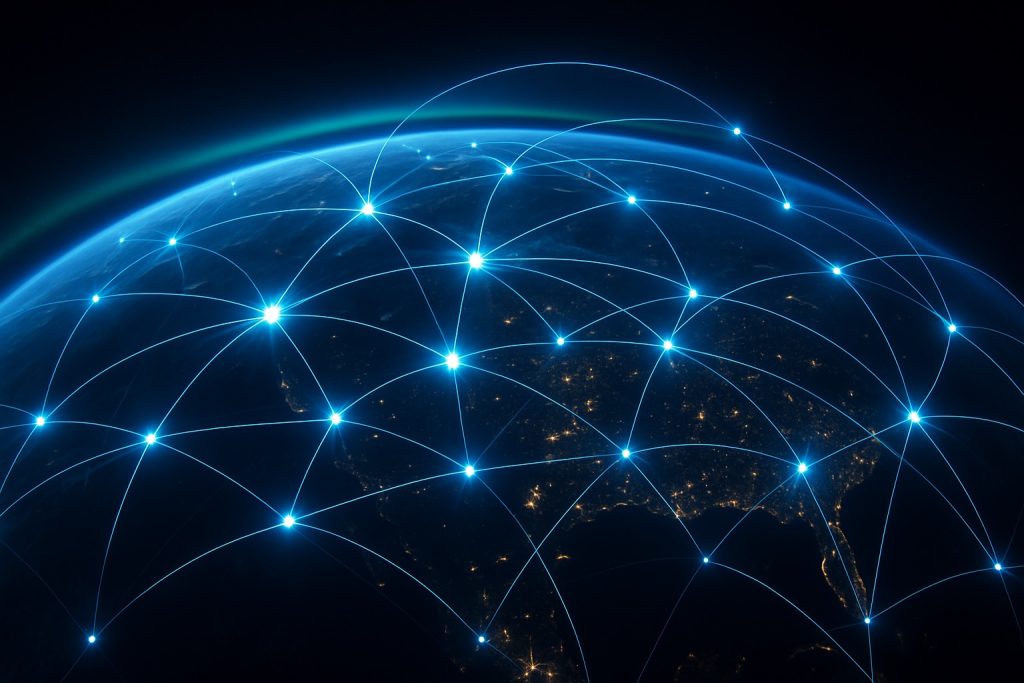- Over 70% of large firms plan to invest in AI-driven security tools by 2027.
- In early 2022, a multinational technology manufacturer faced Babuk ransomware and an AI-driven defense autonomously blocked and isolated the infected device.
- A healthcare company using Darktrace’s UEBA detected an insider attempting data theft by connecting an employee’s device to the Dark Web via Tor.
- Microsoft Security Copilot and Google Chronicle illustrate AI-assisted threat hunting, with Copilot surfacing indicators of compromise in minutes and Chronicle tracing a credential theft attack in a day.
- Since late 2022, phishing email volumes surged by 1,265% following the availability of generative AI.
- WormGPT appeared on underground forums as a ChatGPT‑based tool designed to output malware and phishing content.
- In 2022, researchers demonstrated adversarial manipulation of an AI‑based malware classifier to reduce detection rates.
- In 2020, criminals used AI-based voice cloning to perpetrate a $35 million deepfake scam in the United Arab Emirates.
- The EU AI Act is expected to fully apply by 2025–2026, with high‑risk AI subject to stricter testing and transparency, and ENISA has released a framework for AI cybersecurity practices.
- By around 2030, a large enterprise might have an AI‑based platform that monitors all network activity, automatically deploys decoys, isolates infected hosts, and reconfigures network segments to contain breaches.
Introduction
Artificial Intelligence (AI) refers to computer systems performing tasks that typically require human intelligence, such as decision-making and pattern recognition [1]. Cybersecurity, on the other hand, is the practice of protecting systems, networks, and data from digital attacks [2]. In recent years, these two domains have converged in transformative ways. AI techniques are being applied to enhance cybersecurity defenses, bringing speed and adaptability to threat detection and response. At the same time, new threats have emerged that target AI systems themselves or leverage AI for malicious purposes [3]. This dual reality – AI as both a defender and a potential adversary – defines the modern cybersecurity landscape. Organizations worldwide are embracing AI-driven security tools (over 70% of large firms plan to invest in them by 2027 [4]) to combat increasingly sophisticated cyber attacks. Yet, the rise of AI-powered cybercrime – from AI-crafted phishing emails to deepfake scams – means cybersecurity strategies must also account for securing AI systems and countering AI-empowered threats. In short, the convergence of AI and cybersecurity has created a high-stakes “arms race,” forcing defenders to innovate even as attackers find new ways to exploit intelligent technology [5] [6].
Current Situation
AI in Cybersecurity Today
AI is already transforming cybersecurity operations. Machine learning models and automated algorithms are embedded in many security tools to help spot threats faster and with greater accuracy than traditional methods. Key applications of AI in cybersecurity today include:
- Threat Detection and Anomaly Recognition: AI excels at sifting through enormous volumes of network traffic, logs, and user behavior data to identify suspicious patterns. For example, ML-based security systems can learn what “normal” network activity looks like and then flag deviations that might signal an intrusion [7]. This enables real-time detection of advanced threats – such as stealthy advanced persistent threats (APTs) or fileless malware – that signature-based tools might miss. AI models trained on massive datasets can categorize malicious vs. benign activity more efficiently, improving detection rates. Notably, AI’s pattern recognition can also reduce false alarms; by analyzing contextual factors, AI-driven systems cut down on false positive alerts and help security teams focus on genuine threats [8].
- Automated Incident Response: Speed is crucial during cyber incidents, and AI is helping automate and accelerate response actions. In modern Security Operations Centers (SOCs), AI systems correlate data across firewalls, intrusion detection systems (IDS), endpoints, and other platforms to investigate an alert within seconds [9]. Upon detecting a likely attack (say, ransomware on a network), an AI-driven platform can immediately perform triage: isolating affected hosts, blocking malicious connections, or initiating backups – all in minutes rather than hours [10]. This rapid, automated response significantly limits damage compared to purely manual reaction. For instance, if ransomware begins spreading, an AI system might quickly identify the root cause and quarantine impacted systems, containing the threat before it paralyzes the entire network [11]. Such autonomous response capabilities are increasingly built into advanced “SOAR” (Security Orchestration, Automation and Response) tools.
- Behavioral Analytics and Insider Threat Detection: AI is deployed to establish baseline profiles of user and entity behavior and then alert on anomalies. This is critical for catching insider threats or compromised accounts. User and Entity Behavior Analytics (UEBA) solutions use machine learning to learn each user’s normal login times, access patterns, and data usage. If an employee’s account suddenly downloads a trove of data at 3 AM or accesses systems never touched before, AI flags it for investigation. A real-world example comes from a healthcare company that used an AI security system (by Darktrace) to catch an insider attempting data theft: the AI detected the employee’s device connecting to the Dark Web via Tor – an unprecedented behavior in that environment – allowing the security team to intervene [12]. By recognizing subtle behavior shifts that traditional rule-based systems might ignore, AI-driven analytics can uncover both malicious insiders and stealthy external intrusions.
- Predictive Security and Threat Intelligence: Beyond reacting to attacks, AI is helping organizations anticipate them. Machine learning models can analyze historical incident data and global threat intelligence to predict emerging vulnerabilities or attack trends [13]. For example, predictive analytics might reveal that certain network misconfigurations or unpatched software are likely to be targeted next, prompting preemptive strengthening of those areas. Some financial institutions use AI to spot early indicators of credential-stuffing attacks or fraud by recognizing patterns that preceded past breaches [14]. Similarly, AI can digest threat intelligence feeds (such as dark web chatter or malware telemetry) far faster than humans, surfacing relevant warnings (e.g. a new exploit technique) so that defenders can prepare in advance. This use of AI for proactive defense could significantly reduce the window between vulnerability disclosure and patching or between an attack campaign emerging and organizations inoculating themselves.
- Security Automation in Routine Tasks: AI’s utility in cybersecurity also extends to mundane but vital tasks like patch management and vulnerability assessment. Intelligent automation can scan thousands of systems to identify missing patches or misconfigurations and even prioritize fixes based on risk, all without constant human effort [15]. For instance, an AI tool might continuously test an environment for known vulnerabilities and auto-generate a remediation plan (e.g. apply Patch X on 200 servers, update config Y on network devices) ranked by potential impact. When a critical flaw is disclosed (say, a severe zero-day), AI can rapidly find all affected assets and suggest or initiate patches [16]. This helps organizations close security gaps faster. Automated tasks powered by AI also relieve overburdened security teams from alert triage, log correlation, and other repetitive work – allowing analysts to focus on complex threats and strategic improvements.
The net effect of these applications is that AI is augmenting human cybersecurity teams by handling scale and complexity: it can monitor more data sources, react in microseconds, and detect patterns too subtle or voluminous for manual methods. Consequently, businesses are seeing improved threat detection rates and more efficient responses. Table 1 below summarizes some major AI applications in cybersecurity and their benefits and limitations:
| AI Application | Benefits | Limitations |
|---|---|---|
| Threat Detection & Anomaly Identification | – Enhanced detection of new or stealthy threats: AI analyzes vast traffic and user behavior data to catch abnormal patterns that might indicate malware or intrusions, improving real-time threat detection [17]. <br/>- Fewer false positives: By learning contextual “normal” behavior, AI systems reduce alert noise, allowing analysts to focus on real attacks [18]. | – Evasion by adversaries: Attackers can modify malware signatures or tactics to exploit blind spots in AI models, potentially evading detection [19]. <br/>- Model inaccuracies: If not trained on diverse, high-quality data, AI detectors may misclassify benign behavior as malicious (false positives) or miss novel attack patterns (false negatives). |
| Automated Incident Response | – Lightning-fast containment: AI triggers containment actions (blocking IPs, isolating hosts, etc.) within minutes of detecting an incident, limiting damage far faster than manual response [20]. <br/>- 24/7 consistency: Automated responders don’t sleep – they can react to threats at any hour, maintaining constant vigilance. | – Over-automation risks: Without human oversight, an AI might take improper actions based on misidentification – e.g. disconnecting a critical system due to a false alarm. Human review is needed for truly sensitive responses [21]. <br/>- Complex setup: Tuning AI response playbooks to an organization’s environment can be complex; if misconfigured, response AI could fail to act or act in undesired ways. |
| Behavioral Analytics (Insider Threat & Fraud Detection) | – Detecting the unseen: AI spots insider misuse or account compromises by learning normal user patterns and flagging anomalous activities (like unusual logins or large data downloads), catching threats that evade traditional rules [22]. <br/>- Adaptive learning: These systems continuously adapt to new behavior baselines (e.g. new employees or changing work patterns) to refine their accuracy over time. | – Privacy concerns: Monitoring user behavior at a granular level can conflict with data privacy norms; sensitive information must be handled carefully [23]. <br/>- Bias and errors: AI models might erroneously flag certain individuals or groups as “high risk” due to biased training data or flawed algorithms [24], raising ethical and legal issues if decisions (like investigations or access revocations) unfairly target innocent users. |
| Predictive Threat Analytics | – Proactive defense: By analyzing trends in past incidents and global threat data, AI can predict likely attack methods or targets (e.g. which vulnerabilities are likely to be exploited next) [25]. This foresight helps teams shore up defenses before attacks strike. <br/>- Risk prioritization: Predictive models can assign risk scores, guiding security spend and patching toward the most probable threats rather than purely reactive measures. | – Reliance on historical data: Predictions are only as good as the data; completely novel threats or tactics might not be foreseen if they have no historical analogue. <br/>- False sense of security: Organizations might become complacent, trusting AI forecasts too much. If the model misses a critical emerging threat, the surprise attack could be devastating. |
| Vulnerability Management & Patch Automation | – Scale and efficiency: AI-driven scanners autonomously comb through IT assets to identify vulnerabilities or misconfigurations, then can automate patch deployment or configuration fixes at scale [26] – a task next to impossible to do manually across thousands of systems. <br/>- Risk-based patching: AI can analyze vulnerability severity and the organization’s specific context to prioritize which issues to fix first (e.g. patching an externally exposed server takes precedence over an isolated device), optimizing use of resources. | – Initial investment & complexity: Deploying AI for asset management can be costly and complex, often requiring specialized tools and expertise [27]. Smaller organizations may struggle with the upkeep (continuous model training, data integration) that such AI solutions demand. <br/>- Potential errors: If an AI system incorrectly assesses a patch as safe or necessary, it could apply changes that disrupt systems. Thus, checks and balances are needed to review automated changes in critical environments. |
Table 1: Key applications of AI in cybersecurity, with their benefits and limitations.
Cyber Threats Targeting AI Systems
While AI is bolstering cyber defenses, it has simultaneously become a target for attackers. Malicious actors are exploring ways to trick, evade, or corrupt the very AI models used in security – as well as leveraging AI for new attack techniques. Two significant aspects of this phenomenon are adversarial attacks on machine learning systems and the rise of AI-powered cybercrime:
- Adversarial Attacks on ML Models: Just as traditional software can be hacked, AI systems have unique vulnerabilities. Attackers can employ adversarial machine learning techniques to undermine an AI’s integrity or effectiveness [28]. Common methods include data poisoning, where an attacker injects bad data into the AI’s training set so that it learns incorrect patterns [29]. For example, if criminals can tamper with logs used to train a threat-detection model, they might trick it into treating malware traffic as normal. Another tactic is model evasion: crafting inputs that fool an AI at runtime. Slightly manipulating a malware file’s features or a network packet’s characteristics can exploit an AI detector’s “blind spots,” causing it to misclassify the malicious item as benign [30]. Model extraction attacks are also a concern – here, the attacker probes an AI system (like a cloud-based malware scanner or an AI authentication system) to gradually infer the underlying model or sensitive training data [31]. Such extraction could reveal proprietary algorithms or confidential data that was used to train the model. These threats mean that AI models themselves require protection measures. If a cybersecurity AI can be made to fail or turn malicious, it becomes a weak link. Indeed, security researchers and standards bodies (like the EU’s ENISA) emphasize securing the AI supply chain and building robust, trustworthy AI that can resist adversarial manipulation [32].
- AI-Powered Cybercrime: Threat actors are not only attacking AI – they are wielding it. With the advent of accessible AI tools, cybercriminals can increase the scale and sophistication of their attacks. A vivid current trend is the use of generative AI (like large language models) to craft more convincing phishing and social engineering lures. Since late 2022, when generative AI became widely available, phishing email volumes have exploded. One analysis noted a 1,265% increase in malicious phishing emails following the launch of ChatGPT, as criminals use AI chatbots to generate highly personalized and grammatically flawless scam messages [33]. Unlike clumsy spam of the past, AI-written phishing emails can mimic a company’s style or an individual’s tone, making them dangerously persuasive. Attackers are also creating their own illicit AI bots – for instance, “WormGPT” emerged on underground forums as a ChatGPT-based tool without ethical safeguards, explicitly designed to assist in writing malware and phishing content [34] [35]. By training on malware code and hacker discussion data, such AI can output functioning malicious scripts or hacking strategies on demand. This puts some advanced capabilities (e.g. coding a new ransomware variant or automating target research) into the hands of less-skilled attackers, lowering the barrier to entry for cybercrime.
The integration of AI into cyber offensive tools doesn’t stop at phishing. Adaptive malware is a growing reality – malware that can use AI to re-encrypt or morph itself if it senses it’s being detected, akin to a shape-shifter. Experimental examples of malware that employs machine learning to dynamically decide its next steps have been documented by security researchers [36]. Similarly, AI can automate target selection by scanning for vulnerable systems faster than humans. On the defensive side, experts warn that we are entering an “AI vs AI” contest, where attackers’ AI tries to outsmart defenders’ AI. Palo Alto Networks’ threat intelligence unit notes that cybercriminals have already begun using AI to create personalized “smishing” (SMS phishing) messages and to find ways to blind machine-learning based detection systems [37]. They predict that by 2026, most advanced attacks will employ some form of AI, making cyber defense a continuous AI arms race where each side rapidly iterates new techniques [38].
In summary, AI is a double-edged sword in cybersecurity’s current situation. It is dramatically improving defense capabilities – enabling faster, smarter responses to threats – but it is also introducing new threats as attackers find ways to abuse AI or target the algorithms themselves. Security teams must not only harness AI, but also develop strategies to secure AI models and counter AI-driven attacks in this evolving landscape [39].
Case Studies
Real-world incidents illustrate both the power of AI in cybersecurity and the potential havoc AI can wreak when misused or attacked. Below are a few notable case studies on this dynamic interplay:
AI-Driven Cybersecurity Tools in Action
Stopping Ransomware with Autonomous Defense: In early 2022, a multinational technology manufacturer became the target of Babuk, a notorious double-extortion ransomware. The company had deployed an AI-driven cybersecurity system, which turned out to be crucial. In the middle of the night, the AI monitoring the network noticed an unusual pattern: one device started performing network scans and making odd connections to multiple internal machines [40]. Given its learned understanding of normal “patterns of life” for that device, the AI immediately flagged this as malicious – it recognized the hallmarks of ransomware attempting to spread. Without waiting for human intervention, the AI system autonomously took action to neutralize the threat. It blocked the anomalous connections and isolated the suspicious device, halting the attack in its tracks [41]. Importantly, it did so with surgical precision, allowing normal operations to continue on the rest of the network [42]. A post-incident analysis confirmed that the device had been infected and was trying to propagate Babuk ransomware. Thanks to AI, the ransomware was contained before it could disrupt production or encrypt any critical data. This case demonstrates how AI-based defenses can detect subtle early indicators of an attack (like network scanning behavior at odd hours) and respond instantly, limiting damage. Such capabilities are especially valuable as attacks increasingly occur at machine speed and off-hours when staff might not be watching.
Insider Threat Thwarted by Behavioral AI: Another example comes from the healthcare sector. A large medical research company had an AI security platform monitoring its users and devices. In one incident, the AI flagged that an employee’s workstation was accessing the Tor network (commonly used to browse the Dark Web) – an activity no other company device had done before [43]. This alert prompted a swift investigation, revealing that the employee was attempting to steal intellectual property and sell it on a Dark Web forum. Here, traditional security tools might not have caught an employee simply browsing websites, but the AI’s understanding of normal vs. abnormal behavior tipped off the security team to a serious insider threat. The case underscores AI’s value in detecting human-factor threats by baselining behavior: even without a known signature of “insider theft,” the anomaly was enough to raise an alarm and prevent a data breach.
Augmenting Threat Intelligence: Large tech companies are also using AI to digest threat intelligence and hunt threats proactively. For instance, Microsoft’s cybersecurity suite incorporates an AI called “Security Copilot” that leverages OpenAI’s GPT models on security data. While a specific incident is not public, Microsoft claims this AI assistant has helped analysts identify indicators of compromise across an enterprise in minutes by correlating logs and threat feeds – tasks that would take analysts many hours. Similarly, Google Chronicle (a cloud SIEM) uses AI to parse billions of events for correlations, which helped one Fortune 500 company trace the source of a credential theft attack within a day, whereas previously it remained unsolved. These cases, while anonymized, show that AI is amplifying human analysts: providing faster insights and connecting dots in complex, noisy data that would otherwise remain unnoticed.
Malicious Use of AI and Attacks on AI – Real Incidents
Deepfake Audio Heist – AI as a Weapon: One of the most dramatic instances of AI being used maliciously is the $35 million deepfake voice scam that struck a company in the United Arab Emirates. In 2020, criminals used AI-based voice cloning to impersonate a company director’s voice and trick a bank manager into transferring funds. The fraudsters combined fake audio with forged emails to convince the victim that a legitimate business acquisition payment was urgently needed [44]. The branch manager, hearing what sounded exactly like the director’s voice on the phone, believed it was genuine and approved the transfer – only later discovering it was a hoax. This incident, one of the first of its kind, shows how generative AI can facilitate social engineering at an alarming level of believability. It followed a similar 2019 case in which a UK company’s CEO voice was faked to scam €220,000 [45]. The success of these attacks hinged on trust and human nature – people tend to trust a familiar voice. AI made it possible for criminals to mimic that familiarity perfectly. Security experts warn that such deepfake techniques will become a standard part of the cybercriminal toolkit [46]. Companies are now advised to implement verification protocols (like secondary authentication for large transfers) as a result – a modern take on “zero trust” applied to voice communications [47].
AI-Generated Phishing and Malware: In 2023, cybersecurity firms began observing an uptick in phishing campaigns that were far more tailored and error-free than usual, raising suspicions that AI was involved. These emails had impeccable grammar, referenced personal details or organizational specifics gleaned from social media, and were often part of larger spear-phishing campaigns. Analysis by SlashNext Threat Labs quantified this trend, reporting a 1,265% surge in phishing emails following generative AI’s availability, and noted that a majority of phishing in 2023 used AI-written text [48]. In effect, AI allowed attackers to craft phishing lures in bulk and with high quality. Likewise, on dark web forums, threat actors shared AI-written malware code snippets. One example shared in mid-2023 was an AI-designed polymorphic malware that could randomly alter its own code to evade detection – something achieved by an attacker prompting an AI coding assistant to repeatedly refine and obfuscate the malware. Security researchers demonstrated how WormGPT, the aforementioned malicious chatbot, could produce a functional ransomware code when given a prompt, and also draft a convincing phishing email impersonating a CEO instructing an employee to send money [49]. While these AI outputs still required some expert tweaking, they drastically reduced the time, skill, and effort needed to launch attacks. This democratization of cybercrime via AI is an unfolding case study that every organization should heed. It emphasizes that not only do we have to defend against AI, but soon we may be defending against AI-generated attacks at scale.
Adversarial Examples Causing Chaos: There have been instances (mostly in research settings, but with real implications) where attackers exploited AI vision systems with adversarial examples. For example, researchers showed that by placing small stickers on a Stop sign, they could make a self-driving car’s AI perceive it as a speed-limit sign – a potentially deadly trick. Translating this to cybersecurity: imagine an adversary subtly modifying a malicious file so that an antivirus AI model “sees” it as benign. In 2022, an academic experiment did exactly this with an AI-based malware classifier, tweaking malware files in ways invisible to human analysts but causing the AI to drop detection rates significantly. Although no major breach has been publicly attributed to such adversarial AI attacks yet, these case studies highlight a lurking danger. They underscore why companies like Microsoft, Google, and OpenAI have launched bug bounty programs for AI systems and are investing in research on AI robustness [50]. The lesson is clear: as AI is incorporated into critical systems, adversaries will test it for weaknesses just as they do any software.
These case studies collectively show that the intersection of AI and cybersecurity is not theoretical – it’s here now. AI has already saved companies by catching threats or mitigating attacks in real time, and it has also enabled spectacular new forms of crime. From thwarting ransomware to pulling off multi-million dollar fraud, AI’s impact is being felt on both sides of the cybersecurity battle. Each example provides insights for organizations: invest in AI to bolster defenses, but stay alert to the novel risks AI brings, whether it’s being fooled by creative attacks or abused by criminals.
Ethical and Regulatory Considerations
The fusion of AI with cybersecurity raises important ethical questions and regulatory challenges globally. As organizations deploy AI-driven security systems and as AI tools make life-and-death decisions in cyber defense, issues of privacy, fairness, accountability, and legal compliance come to the forefront. Below, we explore key considerations:
- Data Privacy and Consent: AI systems often require vast amounts of data to train and operate – including sensitive personal or corporate data gleaned from network traffic, user accounts, emails, etc. This creates tension with privacy laws and ethical data handling. For example, an AI threat detection tool in a hospital might process patient records or medical device data; if not carefully governed, this could violate laws like HIPAA in the U.S. or GDPR in Europe [51]. Organizations must ensure that feeding data into security AI does not mean unbridled surveillance or misuse of personal information. Clear policies and possibly data anonymization techniques are needed so that security goals don’t trample individual privacy rights. We’ve already seen incidents highlighting this risk: in 2023, Samsung had to ban employees from using ChatGPT after some developers pasted proprietary code into it (a third-party AI) which amounted to a data leak [52]. The ethical lesson is that employees and AI systems should only use or share data in ways that individuals have consented to and regulators permit. Regulators worldwide (like data protection authorities in the EU) are paying close attention to how AI handles personal data, and hefty fines have been levied for GDPR violations when AI processes went awry. Therefore, privacy-by-design is crucial – security AIs should be designed to minimize data collection and encrypt or mask personal identifiers where possible.
- Algorithmic Bias and Fairness: AI algorithms, including those in cybersecurity, can inadvertently carry biases from their training data. In a security context, bias might mean the AI unfairly flags certain demographics or locations as “high risk” based on skewed historical incident data. An AI could, for instance, generate more false alerts on activity from a particular region or from certain user roles if those were overrepresented in past incident logs. This raises ethical issues of discrimination and fairness. As noted earlier, behavior-based AI detectors might erroneously single out certain individuals or groups – perhaps due to cultural differences in behavior or simply because of imbalanced data [53]. Such bias not only is unjust but can also lead to missed attacks (if focusing on the wrong indicators) or strained workforce relations (if employees feel unfairly monitored or accused). Globally, there is a call for algorithmic transparency and fairness audits of AI systems. Some jurisdictions (like the EU in its upcoming AI Act) will require high-risk AI systems to demonstrate they have evaluated and mitigated bias. In cybersecurity, ensuring a diverse and representative training dataset and regularly reviewing AI decisions for bias are emerging best practices. Ethically, companies should be upfront about how their AI makes decisions, especially if those decisions could limit someone’s access or label their behavior as suspicious. Accountability is key – if an AI wrongly blocks a user or causes an incident, who is responsible? Organizations must establish clear human accountability for AI-driven actions, rather than deflecting blame onto the algorithm.
- Adversarial Robustness and Safety: The ethical use of AI in security also entails making these systems safe and reliable. If an AI-powered defense tool can be easily fooled by adversarial attacks (as discussed above), deploying it without safeguards could be irresponsible. For example, imagine a scenario where a critical infrastructure provider uses AI to automatically control systems – if hackers manipulate that AI, the consequences could be dire (power outages, etc.). To address this, the cybersecurity community is increasingly focusing on AI robustness. Frameworks like the U.S. NIST’s AI Risk Management Framework (RMF) (released in 2023) provide guidelines to develop AI that is secure, explainable, and resilient to attack. It’s an ethical imperative that AI in security does not itself become a single point of failure. There’s also the notion of fail-safe design: ensuring that if the AI encounters something it doesn’t understand or is at risk of being tricked, it fails in a safe manner (perhaps defaulting to human control or a conservative action). From a regulatory perspective, sectors like automotive or healthcare, which increasingly use AI, have safety standards that are beginning to encompass cybersecurity of AI as well. For instance, the EU AI Act classifies certain AI systems (those in safety-critical areas or that could significantly impact people) as “high-risk” and imposes strict requirements for testing, transparency, and risk mitigation [54]. While a SOC automation tool might not fall directly under high-risk, any AI that could autonomously disrupt services likely would.
- Global Regulations and Standards: The regulatory landscape for AI in cybersecurity is rapidly evolving. Europe’s AI Act (2024) is the first comprehensive AI law, taking a risk-based approach to mandate that AI systems meet certain requirements (like risk assessment, documentation, human oversight) proportionate to their potential impact [55]. A security AI used in critical infrastructure, for example, might be considered high-risk and thus need to comply with stringent standards for accuracy and transparency. Additionally, existing cybersecurity regulations are being updated to consider AI. The EU’s NIS2 directive and Cyber Resilience Act, for example, include provisions for secure software which could apply to AI components. Regulators are also aware of AI-enabled threats: agencies such as Europol and the U.S. FBI have issued warnings and guidelines about deepfakes and AI-authored attacks, effectively recognizing these as new classes of cybercrime. On the flip side, data protection laws like GDPR (EU) and CCPA (California) already affect AI deployments in security, since they limit how personal data can be processed and transferred – relevant when AI monitors user activities. Globally, bodies like the OECD have published AI principles emphasizing trustworthy AI (inclusive of security, fairness, transparency) [56], and at least 60 countries have some national AI strategy that often highlights security considerations. Moreover, industry standards are emerging: ISO/IEC is working on standards for AI system management, and ENISA (the European cybersecurity agency) has released a framework for AI cybersecurity practices covering the entire AI lifecycle [57]. For organizations, keeping track of these regulations is essential. Non-compliance can result in legal penalties, and beyond that, adhering to robust standards is simply good practice to maintain customer trust.
- Ethical Dilemmas in Autonomous Defense: As AI takes a bigger role in decision-making, organizations face new ethical dilemmas. For instance, is it acceptable for an AI to automatically shut down a service or lock out a user account if it suspects an attack? What if that decision is wrong – who bears the cost? In high-stakes environments (like a self-driving car or an AI-managed power grid), the question becomes one of allowing AI to make potentially life-impacting decisions. In cybersecurity, an AI might decide to isolate a critical hospital system due to a false malware alert, potentially endangering patients. Ethically, most experts urge a balance: human-in-the-loop approaches for critical actions [58]. This means AI can recommend and even initiate responses, but humans should have oversight and the ability to intervene or review actions that could affect safety or fundamental rights. Another ethical angle is the use of AI for surveillance and state cyber operations. There is a thin line between cybersecurity and violating privacy when AI is used by governments to monitor networks for threats – something that must be handled with legal oversight and transparency to avoid abuse.
In conclusion, deploying AI in cybersecurity is not just a technical endeavor; it comes with responsibilities. Companies must navigate privacy laws, ensure their AI isn’t discriminating or making unjust decisions, and adhere to emerging regulations that demand AI systems be transparent, secure, and accountable. Ethical practices – such as obtaining consent for data use, being open about AI-driven policies, and continuously auditing AI outcomes – will differentiate organizations that successfully leverage AI from those that court controversy or legal troubles. The world’s governments and standards bodies are clearly signaling that AI must be trustworthy and human-centric [59]. In the realm of cybersecurity, that translates to AI that not only effectively fights threats, but does so in a way that upholds the values of privacy, fairness, and the rule of law.
Forecast (5–10 Years)
Looking ahead over the next five to ten years, the interplay between AI and cybersecurity is poised to deepen even further. We can expect significant innovations, new risks, and strategic shifts that will redefine how organizations protect themselves in the 2030 timeframe. Here are some key forecasts for the future of AI in cybersecurity (and vice versa):
- AI as a Standard in Defense – Toward Autonomous Security: Within 5–10 years, AI-driven security solutions will likely become a standard component of enterprise and national defense systems. We will see more autonomous incident response capabilities maturing – essentially “self-driving” cybersecurity systems. These AI systems will detect threats and execute countermeasures with minimal human intervention, much like an autopilot for cyber defense. For example, by 2030 a large enterprise might have an AI-based platform that monitors all network activity, detects an infiltration attempt, automatically deploys a decoy or honeypot to trap the attacker, and simultaneously reconfigures network segments to contain the breach. If this sounds far-fetched, consider that basic versions of such autonomy already exist in products today; the next decade will refine and trust them further. In fact, experts predict that SOCs (Security Operations Centers) will be AI-led, with humans supervising. An analogy is often made to commercial air travel: most of the “flying” is done by sophisticated autopilot (AI) with pilots overseeing and handling exceptions. Similarly, the future SOC might have AI handling routine triage, investigation, and even remediation, while human analysts focus on strategy, creative threat hunting, and oversight [60] [61]. We can expect an era of autonomous or semi-autonomous SOCs, which will be crucial given the speed and volume of attacks.
- The AI Cyber Arms Race Escalates: Unfortunately, just as defense AIs will improve, attacker AIs will too. The next 5–10 years will likely see a continuous AI arms race in cyberspace [62]. By 2026 or soon after, analysts project that the majority of sophisticated attacks will involve some AI element, whether for reconnaissance, exploit development, or adaptive attack execution [63]. We might see AI-driven malware that can dynamically change tactics if it detects it’s being countered (for instance, switching from a stealth mode to an aggressive spread if quarantined). Social engineering attacks will become even more convincing with advanced deepfake videos and real-time AI voice impersonation on phone calls, making scams harder to spot. Nation-state adversaries are presumably already exploring AI to find zero-day vulnerabilities or to automate attacks on critical infrastructure. A frightening possibility is AI-assisted cyber-physical attacks – imagine an AI analyzing a utility company’s schematics (perhaps stolen) and identifying the perfect sequence to disrupt operations or cause physical damage [64]. The World Economic Forum and others have warned that by 2030, attacks on autonomous vehicles, medical devices, or industrial robots could be orchestrated by hostile AIs, given those systems’ complexity. Essentially, defenders will face not just human hackers, but machine-speed, AI-enhanced assaults that require equally fast and intelligent defenses.
- Fusion of AI with Other Emerging Tech (Quantum, IoT): The next decade will also see AI in cybersecurity intersecting with other technologies. Quantum computing is expected to threaten traditional cryptography by the late 2020s, potentially breaking current encryption methods [65]. AI will play a role here both in offense and defense: AI algorithms might help manage the transition to quantum-resistant encryption by identifying vulnerable assets and automating cryptographic updates. Conversely, malicious actors might use AI to optimize quantum attacks on encryption (should such capabilities materialize). The Internet of Things (IoT) and cyber-physical systems will proliferate (smart cities, connected cars, implants, etc.), dramatically expanding the attack surface. Securing these will likely rely on AI due to the sheer scale – think millions of devices transmitting data. AI-based anomaly detection will be deployed at the edge (on devices themselves or edge gateways) to spot intrusions or malfunctions in real time. For example, a smart factory in 2030 may use AI to monitor robotic assembly lines for any sign of sabotage or abnormal behavior indicative of a cyber attack. The downside is attackers might use AI to discover systemic weaknesses in IoT ecosystems or to coordinate large-scale attacks (like herding swarms of compromised IoT devices for intelligent botnets that evade detection). The convergence of AI, IoT, and 5G/6G networks might necessitate new security paradigms – possibly AI-driven “immune systems” where countless devices collectively learn and adapt to threats.
- Greater Emphasis on AI Security and Regulation: In the coming years, there will be much more focus on securing AI systems themselves – spawning a subfield sometimes dubbed “AI Security” or “secure AI engineering”. Just as “application security” became a staple in IT, companies will formally incorporate adversarial testing for AI models, supply chain security for AI data and code, and continuous monitoring of AI behavior for anomalies (to catch if an AI model is compromised). We may see tools that act like an antivirus for AI models – scanning them for signs of tampering or abnormal outputs. Regulation will likely push this forward: for example, the EU AI Act will fully apply by around 2025–2026, enforcing robustness and security requirements for high-risk AI. Other regions may follow with their own laws or adopt similar standards (the OECD is guiding on AI governance, and countries like the U.S. are considering legislation too). By 2030, it is plausible that any AI system used in a critical cybersecurity capacity will need to be certified for security (akin to how cryptographic modules can be FIPS certified). Governments might also require more transparency from AI vendors about how their models work (to assess bias and security). In addition, as AI pervades defense, international norms or treaties could emerge – for instance, discussions in the UN about curbing AI-enhanced cyber warfare or agreeing on norms for responsible AI use by intelligence agencies. In summary, trust and verification will be a theme: trust in AI will be built by proving its security and reliability, not just its performance.
- Augmented Cybersecurity Workforce and Skill Shift: The role of human professionals in cybersecurity will certainly evolve. AI will handle more grunt work, but human expertise remains vital. In five years, a lot of entry-level analysis might be automated, but new roles will rise – like AI Cybersecurity Strategist or AI Auditors who specialize in overseeing AI systems. Analysts will need skills in understanding and interpreting AI outputs (AI explainability) and in investigating incidents possibly involving AI (like figuring out how an AI was deceived). There’s also a concern: Gartner predicts that by 2030, 75% of SOC teams will experience “skill erosion” because automation handles so much that people lose practice [66]. If AI were to fail or be unavailable, those teams might struggle. To counter this, organizations will need to retain and train humans in core security fundamentals – essentially to serve as a backup and sense-check for AI. We might even see regulatory requirements for “human fallback” in critical security operations, similar to how some aviation and medical regulations require manual override options. On a positive note, AI could help narrow the cybersecurity talent gap by taking on work, enabling smaller teams to secure large infrastructures. The profession might shift towards more high-level decision-making, threat hunting (with AI tools), and creative adversarial thinking to anticipate what attacker AIs might do.
- Potential Innovations: By the latter part of this decade, some intriguing innovations could become reality. One is AI-driven deception technology – adaptive honeypots and fake assets controlled by AI that actively engage with intruders, learn their tactics, and feed misleading data. This could confuse and slow down attackers while gathering intelligence about them. Another is predictive orchestration: using AI not just to predict attacks, but to dynamically reconfigure networks and systems before an attack hits (like changing configurations when risk is deemed high, akin to raising a cyber shield preemptively). Also, collaborative AI defense networks might emerge, where companies securely share anonymized threat data to a cloud AI which learns from attacks on any participant and instantly advises all members – creating a sort of community immune system. This could be facilitated by advancements in privacy-preserving AI (so that sharing doesn’t leak sensitive info) and would be a powerful response to fast-moving threats like global malware outbreaks. On the attacker side, we have to consider worst-case scenarios like AI-designed exploits: an AI might discover a vulnerability and also design a tailor-made exploit code far faster than a human researcher could. There have already been research projects where AI was tasked with finding software bugs and succeeded in identifying novel vulnerabilities. Coupling that with AI’s ability to write code, it’s conceivable we’ll see autonomous hacking systems that can breach targets with minimal human input – a sort of “automated red team” that could be used by both pentesters and criminals.
In summary, the next 5–10 years will likely bring more AI saturation in cybersecurity – it will be in every tool, every network, and every attacker’s arsenal. This will yield stronger defenses (faster, more adaptive, covering larger attack surfaces) but also more complex risk (as AI failures or adversarial exploits can cause bigger problems). For organizations, success in this period will depend on staying ahead in the AI race: continuously updating AI capabilities, but also building resilience if AI components fail or are spoofed. Those who leverage AI for security proactively – while conscientiously managing its risks – will be far better positioned than those who do not. In fact, cybersecurity might evolve into “cyber resilience” engineering, where AI helps organizations not just keep attackers out, but continue operating through attacks and recover swiftly. The stakes will be higher than ever, but so will the tools at our disposal.
Recommendations
For companies looking to successfully leverage AI in their cybersecurity strategy, a balanced and thoughtful approach is essential. Here are key best practices and recommendations to maximize AI’s benefits while minimizing its risks:
- Maintain Human Oversight and Expertise: No matter how advanced your AI systems are, keep humans in the loop for critical security decisions. AI can rapidly detect and flag anomalies, but final actions such as shutting down systems, blocking user access, or other high-impact responses should involve human confirmation or review [67]. Human oversight helps prevent AI errors or bias from causing harm. It’s wise to treat AI as an augment to your security team, not a replacement. Continue training your analysts in core skills and incident response procedures so they can step in if the AI malfunctions or to handle novel attack scenarios that AI might not recognize [68]. Essentially, aim for a human-AI partnership: AI handles speed and scale, humans handle judgment and exception handling.
- Establish a Clear AI Security Policy: Develop and enforce policies around how AI will be used in your cybersecurity program [69]. This policy should define roles and responsibilities (who manages the AI tools, who validates their decisions), acceptable use (e.g. what data can/can’t the AI access), and fail-safe procedures. Set accountability guidelines: if the AI makes a wrong call, how will it be addressed, and by whom? In regulated industries, ensure the policy aligns with any compliance requirements regarding automated decision-making. A clear policy also means deciding where not to use AI – for instance, you might prohibit fully automated actions on sensitive production systems, or you may ban employees from using external AI tools with company data unless vetted. By outlining these boundaries and expectations upfront, you reduce confusion and risk when AI is deployed at scale.
- Use High-Quality and Diverse Training Data: The effectiveness of AI in cybersecurity is only as good as the data it learns from. Invest in curating high-quality datasets for training your models [70]. This might include logs of past attacks, clean baseline behavior data, and up-to-date threat intelligence. Ensure the data is relevant to your environment – e.g., if you’re training an AI to detect network intrusions, include a mix of normal traffic from your industry and known attack traffic. It’s equally important to filter out noise and biased data. Remove or compensate for any biases (like an overrepresentation of a certain user group in past incident logs) so the AI doesn’t learn skewed patterns that lead to false positives on that group [71]. Whenever possible, incorporate diversity in scenarios – simulate various attack types and benign behaviors – to make the model robust. Don’t one-dimensionally train on only old malware if new AI-enabled malware looks very different. Also, maintain data privacy: anonymize personal data in training sets or use techniques like federated learning where feasible, to stay compliant with privacy laws.
- Combine AI with Traditional Security Layers: AI is not a silver bullet; it works best as part of a multi-layered defense. Continue to use traditional security tools (firewalls, anti-malware, intrusion prevention systems, etc.) and integrate AI systems alongside them [72]. For example, an AI-based anomaly detector can run in parallel with a signature-based IDS – one catches novel patterns while the other reliably catches known threats [73]. This defense-in-depth approach ensures that if AI misses something (or conversely, if the old tools miss a very new attack), the other layers provide coverage. Integration is key: feed AI findings into your SIEM and incident management workflows so that they correlate with alerts from other sources. Think of AI as an enhancement that boosts detection and response across all layers – e.g., AI might prioritize which firewall alerts to focus on, or help endpoint tools by analyzing behavior on the host. Additionally, use AI to complement periodic human processes – like using an AI vulnerability scanner in between manual pen-tests. A holistic, layered strategy prevents over-reliance on any one control and creates a more resilient security posture.
- Keep AI Models and Tools Up-to-Date: Cyber threats evolve quickly, and your AI models must evolve with them. Regularly retrain and update AI models using fresh data (new attack samples, new normal behavior after changes in your environment) [74]. For vendor-provided AI solutions, apply updates and threat signature feeds promptly – reputable vendors will continuously improve their AI based on global insights. Monitor model performance; if you see drift (e.g. an increase in false negatives or false positives), schedule a retraining or tuning session. In addition, incorporate threat intelligence updates into AI models – for instance, if a new phishing tactic is observed globally, feed that knowledge so the AI can catch similar patterns. It’s also recommended to periodically test the AI (red-team it with adversarial scenarios) to see if it can be fooled, and then harden it accordingly. By treating AI models as living systems rather than one-and-done deployments, you maintain their edge. Continuous improvement is the mantra – the attackers won’t stand still, and neither should your AI.
- Implement Strong Security Controls for AI Systems: Protect the AI itself as a high-value asset. Secure the data pipelines feeding the AI (to prevent poisoning attacks) – for example, restrict who can input training data and validate that data’s integrity [75]. Use access controls and encryption for AI model files and platforms [76]. If you’re using an AI SaaS or cloud service, ensure proper authentication (MFA, keys) and monitoring of that access. Limit administrative access to AI dashboards or configuration to only those who need it, and log all changes. It’s also wise to separate the AI environment from general IT as much as possible (network segmentation, etc.), so that if an attacker breaches part of your network, they can’t easily tamper with your security AI. Regularly backup your AI models and configurations – if a model is corrupted or ransomed, you can restore a known-good state. Monitoring is crucial: deploy monitoring on the AI’s decisions/output to catch if it suddenly behaves oddly (which might indicate it’s under attack or malfunctioning). In essence, apply the same (or higher) level of security to your AI systems that you would to critical servers or databases, because compromising the AI could give an attacker a free pass or blind your organization to an ongoing attack [77].
- Plan for Adversarial Resilience and Testing: Make adversarial robustness a standard part of your AI deployment. This means proactively testing how your AI models handle manipulated inputs. You can engage security testers or use open-source tools to perform adversarial testing – for example, slightly alter malware samples to see if your AI still catches them, or test injecting noise into normal data to see if it causes false alarms. By doing this, you identify potential weaknesses in how your AI might be deceived [78]. Work with your AI vendor for guidance; some provide “adversarial ML” evaluation as a feature. Additionally, stay updated on the latest in adversarial attack techniques and defenses (academic research in this area is booming). Incorporate defenses like input sanitization, ensemble modeling (using multiple models and comparing results), or anomaly detectors that watch for inputs intentionally designed to confuse AI. Having an incident response plan specifically for if your AI is compromised or fooled is also important – who would diagnose and fix the model, how would you operate in the meantime, etc. Being prepared in this way ensures that when attackers inevitably target your AI, you won’t be caught off guard.
- Foster a Culture of Security and AI Literacy: Lastly, invest in training and culture. Your security team should be well-versed in how AI tools work – not at a PhD level, but understanding strengths, limits, and basic tuning of the models. This helps them trust but verify AI outputs. Simultaneously, educate all employees about AI-related threats (like deepfake scams, AI-generated phishing). The human firewall is still a critical layer; people should know that just because something looks or sounds very real (video, audio, email), they need to verify sensitive requests through secondary channels (especially as deepfakes rise [79]). Encourage a mindset where AI is leveraged thoughtfully: analysts should feel comfortable questioning an AI’s conclusion if it doesn’t make sense in context (maybe it’s a new type of error). By integrating AI literacy into your cybersecurity training and drills, you ensure that the human and machine elements of your defense work in harmony. Leadership should champion this, making cybersecurity (with AI) a C-suite priority so that adequate resources and attention are given to it [80] [81]. When top management understands both the promise and pitfalls of AI in security, they are more likely to support necessary controls, investments, and ethical practices.
Adopting these best practices will help organizations harness AI’s power to strengthen cybersecurity while staying safe, compliant, and in control. The goal is to gain the advantages of speed, intelligence, and efficiency that AI offers – better threat detection, faster response, improved risk management – without succumbing to new vulnerabilities or ethical lapses. Companies that get this balance right will not only bolster their defense against today’s threats but also build a strong foundation to face the AI-enhanced cyber threats of the future with confidence [82] [83].
References
1. www.coursera.org, 2. www.cisco.com, 3. www.enisa.europa.eu, 4. www.techtarget.com, 5. www.paloaltonetworks.com, 6. www.enisa.europa.eu, 7. www.techtarget.com, 8. www.techtarget.com, 9. www.techtarget.com, 10. www.techtarget.com, 11. www.techtarget.com, 12. www.darkreading.com, 13. www.techtarget.com, 14. www.techtarget.com, 15. www.techtarget.com, 16. www.techtarget.com, 17. www.techtarget.com, 18. www.techtarget.com, 19. www.techtarget.com, 20. www.techtarget.com, 21. www.techtarget.com, 22. www.darkreading.com, 23. www.techtarget.com, 24. www.techtarget.com, 25. www.techtarget.com, 26. www.techtarget.com, 27. www.techtarget.com, 28. www.techtarget.com, 29. www.techtarget.com, 30. www.techtarget.com, 31. www.techtarget.com, 32. www.enisa.europa.eu, 33. www.techtarget.com, 34. www.trustwave.com, 35. www.trustwave.com, 36. techspective.net, 37. www.paloaltonetworks.com, 38. www.paloaltonetworks.com, 39. www.enisa.europa.eu, 40. www.darkreading.com, 41. www.darkreading.com, 42. www.darkreading.com, 43. www.darkreading.com, 44. www.darkreading.com, 45. www.darkreading.com, 46. www.darkreading.com, 47. www.darkreading.com, 48. slashnext.com, 49. www.trustwave.com, 50. www.infosecurity-magazine.com, 51. www.techtarget.com, 52. www.prompt.security, 53. www.techtarget.com, 54. www.enisa.europa.eu, 55. www.enisa.europa.eu, 56. oecd.ai, 57. www.faicp-framework.com, 58. www.techtarget.com, 59. www.enisa.europa.eu, 60. www.pointguardai.com, 61. www.pointguardai.com, 62. www.paloaltonetworks.com, 63. www.paloaltonetworks.com, 64. www.pointguardai.com, 65. www.pointguardai.com, 66. www.pointguardai.com, 67. www.techtarget.com, 68. www.pointguardai.com, 69. www.techtarget.com, 70. www.techtarget.com, 71. www.techtarget.com, 72. www.techtarget.com, 73. www.techtarget.com, 74. www.techtarget.com, 75. www.techtarget.com, 76. www.techtarget.com, 77. www.techtarget.com, 78. www.techtarget.com, 79. www.darkreading.com, 80. techspective.net, 81. techspective.net, 82. techspective.net, 83. www.paloaltonetworks.com










